Interdisciplinary Workshop: “The obscure Middle Ages in Italy”
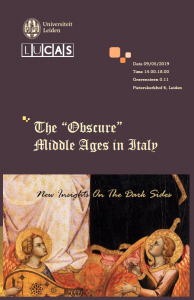
Interdisciplinary Workshop in Italian Studies
For the complete programme, click here
Prof. Peter .C.M. Hoppenbrouwers
‘Pietro d’Abano and the secrets of good citizenship’
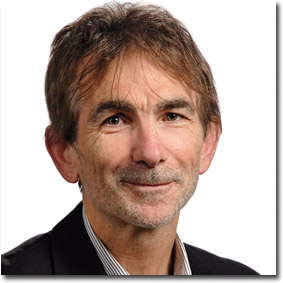
P.C.M. (Peter) Hoppenbrouwers (1954) studied history and Italian literature at Leiden University. He graduated in history in 1978, and was awarded his doctorate in 1992 at Wageningen University for a regional study on late medieval rural life in the villages of the Land van Heusden. From 1984 to 1994 he was Director of the Netherlands Agricultural Historical Institute (NAHI) and lecturer in Agrarian History at Groningen University, from 1994 to 2000 senior lecturer in Medieval History at Leiden University, and from 2001 to 2007 full professor of Medieval History at the University of Amsterdam (UvA). Since 2008 he holds the Chair of Medieval History at Leiden University. Since 2019 he is the Academic Director of the Netherlands Research School for Medieval Studies.
Allegra Baggio Corradi
Misspelt : Cultivating Unclearness in Medieval and Renaissance Italy
This paper investigates the obscure etymology of the term ‘spelt’ through the mapping of the continuities and changes between medieval and early modern textual practices. The paper’s aim is to strengthen the ties between medieval physiology and Renaissance philology, understood as complimentary attempts at diagnosing the level of coherence between words and the world.
Through the study of the so far under-researched fifteenth-century reception of Simon of Genoa’s Key to Healing (? 1288-92), this paper sheds new light upon the work’s importance as a linguistic thesaurus for humanists rather than as a pharmacological summa. This will be demonstrated through Simon’s centrality among the sources employed by Niccolò Leonico Tomeo for the writing of his Bonominus or On Spelt (1524), a dialogue on the etymological root and correct translation of the term ‘alica’ from Greek. Simon’s mediatory role in the transmission, compilation and translation of Jewish, Arabic, Greek and Latin medical terminology in thirteenth-century Rome will be mirrored by Tomeo’s conciliatorist approach to classical, Byzantine and medieval principles of natural science in fifteenth-century Padua. This will allow for a clearer understanding of the strategies used by physiologists and philologists operating two centuries apart in the codification of a language able to articulate the ontological bond between language and nature in an appropriate manner.
Ultimately, the paper seeks to demonstrate how the study of linguistic obscurity can be a valuable instrument for the contemporary historian to reconstruct the ways in which and the reason why man articulates knowledge more or less intelligibly.
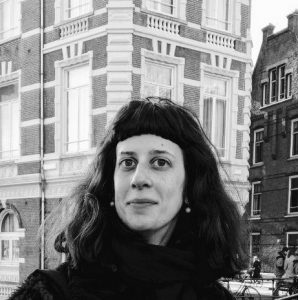 Allegra Baggio Corradi is a PhD student in Cultural and Intellectual History at the Warburg Institute, London. Her research concerns the neoplatonic dialogues of the Paduan philosopher Niccolò Leonico Tomeo (1456-1531). Allegra’s main interest lies at the intersection of early modern humanism and natural history, with a particular focus on the notion of ‘soul’, its life, afterlife and the continuity of its substance. Allegra is currently a visiting research fellow at the Leiden University Centre for the Arts in Society and from September she will also be a visiting researcher at the Scaliger Institute.
Allegra Baggio Corradi is a PhD student in Cultural and Intellectual History at the Warburg Institute, London. Her research concerns the neoplatonic dialogues of the Paduan philosopher Niccolò Leonico Tomeo (1456-1531). Allegra’s main interest lies at the intersection of early modern humanism and natural history, with a particular focus on the notion of ‘soul’, its life, afterlife and the continuity of its substance. Allegra is currently a visiting research fellow at the Leiden University Centre for the Arts in Society and from September she will also be a visiting researcher at the Scaliger Institute.
Jelle Kalsbeek
Soundscapes of Obscurity : Thoughts on Medieval Music
In this paper, I will shine light on the various degrees of obscurity covering medieval music, arguing for the concomitant development in notational and gnoseological practises during the Italian Middle Ages. To this end, I will first consider obscurity from a physical standpoint by assessing the absence of plainchant notation before the 9th century and of Western instrumental music before the 13th century. Secondly, I will assess the obscurity of early forms of notation in Europe in that they only estimate the performance through signs that prompt the performer’s memory. The relative distance between the notes is vague at best and the rhythm can only be estimated based on poetic meter. Lastly, I will consider the connection between musical obscuritas and brevitas as present in the notational practices of the Middle Ages. Since the enigmatic elements of early notation rest primarily on oral tradition and improvisation, the notation can be seen as a form of brevitas. The secretive nature of early notation only allows the orally initiated to read the music, since, unlike the Renaissance, there were no written music instructions. Accompanied by a gradual loss of the implicit clues to the notational ‘riddle’, the demand for standardised music notation is in accordance with other cultural phenomena at the time. Whereas until the 13th century, for example, the notation is only implicit and made of contrasts such as longa and breve, virga and punctum, by the 14th century notation becomes rhythmically precise and varied. It is therefore no coincidence that the then newly discovered works of Aristotle share their name with the exact notational practices of the 14th century, namely Ars Nova. I argue therefore that the gradual switch from subjective and obscure musical performance in the medieval period to exact and clear notation in the Renaissance is in line with philosophical developments.
 Jelle Kalsbeek studied art history, musicology and lute music at the University College Roosevelt and acquired an M.A in cultural and intellectual history, 1300-1650 at the Warburg Institute in London in 2017. Aside from an expertise in early musical practices, he is interested in early modern philosophy of music, a subject on which he has widely published.
Jelle Kalsbeek studied art history, musicology and lute music at the University College Roosevelt and acquired an M.A in cultural and intellectual history, 1300-1650 at the Warburg Institute in London in 2017. Aside from an expertise in early musical practices, he is interested in early modern philosophy of music, a subject on which he has widely published.
Marlisa den Hartog
Lovers in the Dark : The importance of Secrecy in Medieval Love Affairs
This paper explores the importance of secrecy in love affairs in Italy from the Middle Ages to the Early Renaissance, using a variety of source material ranging from sermons and manuals for confession to novella tales and advice literature on how to have a successful love affair.
The first line of inquiry is focused on the gendered nature of love affairs: what type of techniques were women believed to use to “tempt” men, and what techniques did men use to “seduce” women? In the context of the medieval courtship ritual, the more passive temptation part, allowing oneself to be looked at, is mostly played by women, whereas the seduction part, actively doing something to seduce the other, is mostly played by men.
The second line of inquiry focuses on the role that secrecy and discretion played in the degree of acceptance of extramarital love affairs. Literary genres such as the novella express appreciation for those men and (especially) women who at least take the effort of keeping their affairs a secret. Within theological discourse, the gravity of a sexual sin was measured by the degree of publicness of the scandal.
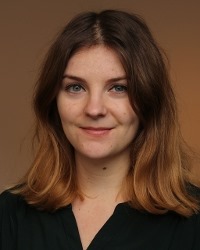 Marlisa den Hartog, MA is PhD candidate at the Leiden Institute for History. She is working on a thesis on perceptions of sexual identity and sexual desire in Italy between 1450 and 1550. Apart from her research, she teaches courses on medieval history and is co-editor of the Leiden Medievalists Blog, which provides a platform for Leiden University medievalists to share their knowledge about the Middle Ages with a broader audience.
Marlisa den Hartog, MA is PhD candidate at the Leiden Institute for History. She is working on a thesis on perceptions of sexual identity and sexual desire in Italy between 1450 and 1550. Apart from her research, she teaches courses on medieval history and is co-editor of the Leiden Medievalists Blog, which provides a platform for Leiden University medievalists to share their knowledge about the Middle Ages with a broader audience.
David Napolitano
Emerging from the Dark : The Guiding Light of the Oculus pastoralis
Playing on the different meanings of the term “obscure” in a modern dictionary, this paper will consist of two different, but intimately related parts. Both parts will deal with the Oculus pastoralis, an anonymous speech collection, interwoven with an introduction to the podestà office, written in communal Italy (1220s). Firstly, this paper will focus on the discovery of a second copy of the Oculus pastoralis previously unknown to – and untapped by – the three editors of the text (Muratori, 1741; Franceschi, 1966; and Tunberg, 1986). It will tell the story of a closed and overly specialized academic community, in which the wrongly catalogued opening text of a miscellany can be known to legal historians but remain unnoticed by its editors, as well as the story of an open and supportive academic community, in which footnotes and email exchanges lead a medieval text to emerge from the dark. Secondly, this paper will discuss the Oculus pastoralis as the earliest surviving representative of the so-called podestà literature, a corpus too often dismissed as “minor works” of literature. It will look into the reasons underlying this unfortunate state of affairs, advocate the need for renewed interest in this type of literature, and present the central political message of this text, thus allowing the Oculus pastoralis to shine – once again – its guiding light on the path to good government.
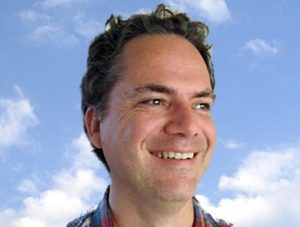 Dr. mr. D(avid) P.H. Napolitano is currently attached as a University Lecturer to the Institute of History at Leiden University, after having completed a British Academy Postdoctoral Fellowship at the University of Cambridge (2015-2018). Having written his PhD thesis on the Italian podestà literature (Cambridge, 2011-2014), his academic interest has broadened from communal Italy to the cities of the Low Countries and the Rhine Area. He is particularly interested in the gradual development of a professional profile and code of conduct for the city magistrate and its role in building political trust.
Dr. mr. D(avid) P.H. Napolitano is currently attached as a University Lecturer to the Institute of History at Leiden University, after having completed a British Academy Postdoctoral Fellowship at the University of Cambridge (2015-2018). Having written his PhD thesis on the Italian podestà literature (Cambridge, 2011-2014), his academic interest has broadened from communal Italy to the cities of the Low Countries and the Rhine Area. He is particularly interested in the gradual development of a professional profile and code of conduct for the city magistrate and its role in building political trust.
Valerio Cappozzo
Medieval Dream : The Interlinked Worlds of Imagination and Reality.
This paper presents the results of research on the transmission of the Somniale Danielis in Latin and Italian manuscript sources. Widely circulated in the late Middle Ages, this dream manual was structured so that key terms in the text corresponded to the subjects of the dreams.
My work presents a dictionary of medieval dream symbols, and is based on editions of codices in Latin and Italian, going from the 9thto the beginning of 16thcentury, and it also includes the first Latin and vernacular printed versions of the Dictionary from 1475 to 1550. The form of the work has its origins in early 4thcentury A.D. Greek manuscripts, and thrived in the Middle Ages mainly in Arabic, Latin, and the European languages.
This dictionary of dream symbols contains around 650 different symbols, each of which has many variations, for a total of around 5000 possible interpretations. Such materials can help advance our knowledge of medieval and early modern creativity in relation to the interlinked worlds of imagination and reality.
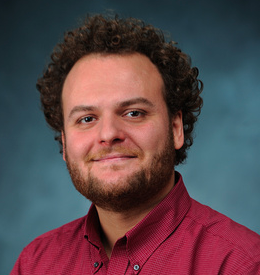 Dr. Valerio Cappozzo is Assistant Professor and Director of the Italian Program at the University of Mississippi. His research focuses mainly on the manuscript tradition of dream sciences and their literary application in early Italian poetry. On this topic he has recently published his monograph titled The Medieval Dream Dictionary. The Somniale Danielis in Literary Manuscripts (Leo. S. Olschki Editore, Florence 2018). It presents an edition of a widely circulated dream manual, the Somniale Danielis, from the ninth century to 1550. Cappozzo is now working on dream-interpretation in the Renaissance and on the concept of Cultural Diplomacy between Christians and Muslims in the Middle Ages. On this topic he is editing a volume titled Boccaccio and Islam. Islam and Boccaccio and analyzing the Arabic reception of Dante’s Comedy.
Dr. Valerio Cappozzo is Assistant Professor and Director of the Italian Program at the University of Mississippi. His research focuses mainly on the manuscript tradition of dream sciences and their literary application in early Italian poetry. On this topic he has recently published his monograph titled The Medieval Dream Dictionary. The Somniale Danielis in Literary Manuscripts (Leo. S. Olschki Editore, Florence 2018). It presents an edition of a widely circulated dream manual, the Somniale Danielis, from the ninth century to 1550. Cappozzo is now working on dream-interpretation in the Renaissance and on the concept of Cultural Diplomacy between Christians and Muslims in the Middle Ages. On this topic he is editing a volume titled Boccaccio and Islam. Islam and Boccaccio and analyzing the Arabic reception of Dante’s Comedy.
Member of the editorial board for scholarly journals and publishing houses, he is member of the scientific committee of the Fondazione Giorgio Bassani, of the Dante Society of America, the Medieval Academy of America, the Renaissance Society of America and currently he is the secretary of the American Boccaccio Association and co-Editor-in-Chief of the scholarly journal «Annali d’Italianistica».
Roundtable: Closing remarks
Host and scientific organizer: Carmen Van den Bergh
Organizing committee: Le Tre Corone, Italian language and Culture
